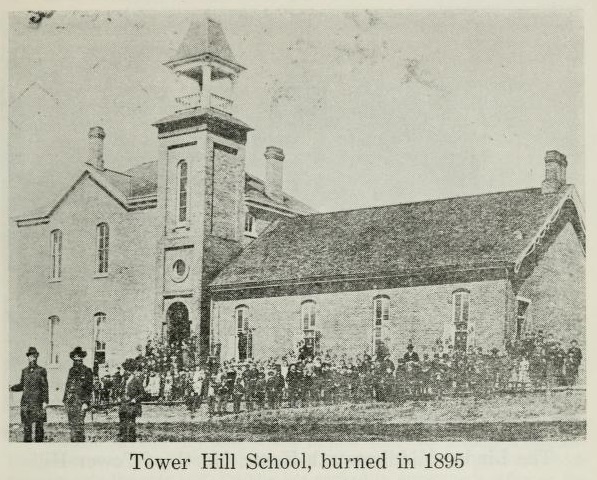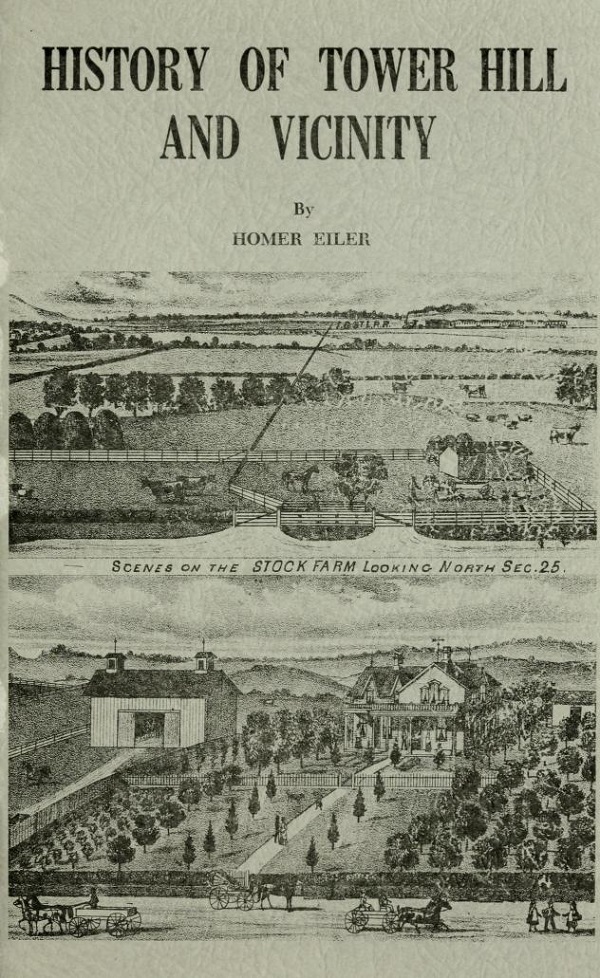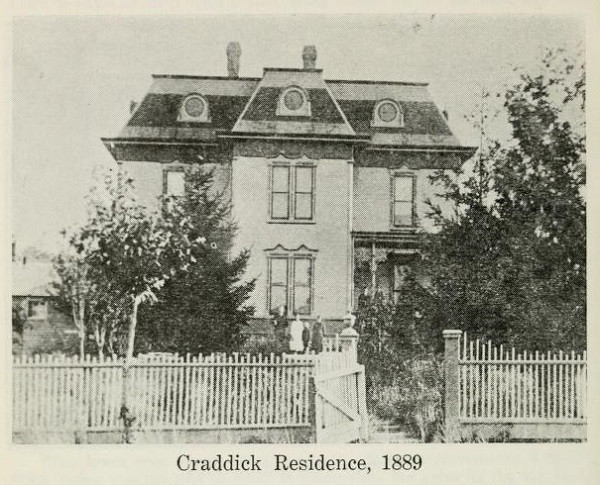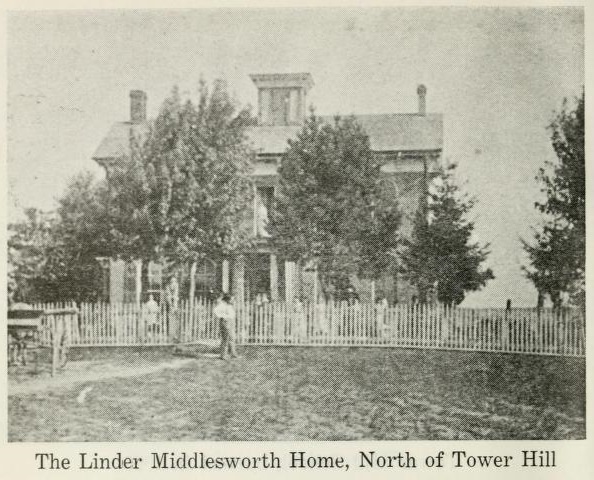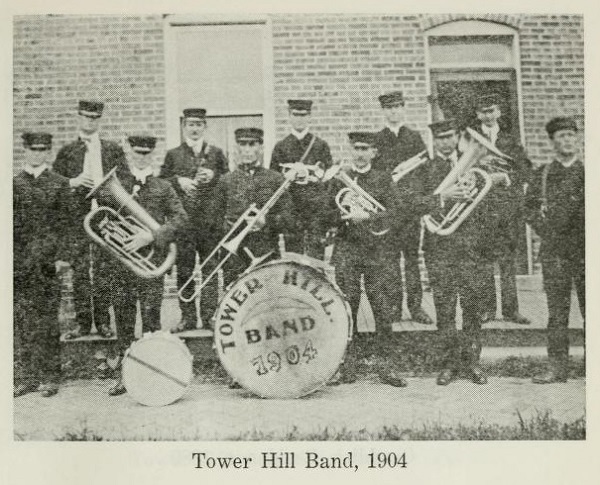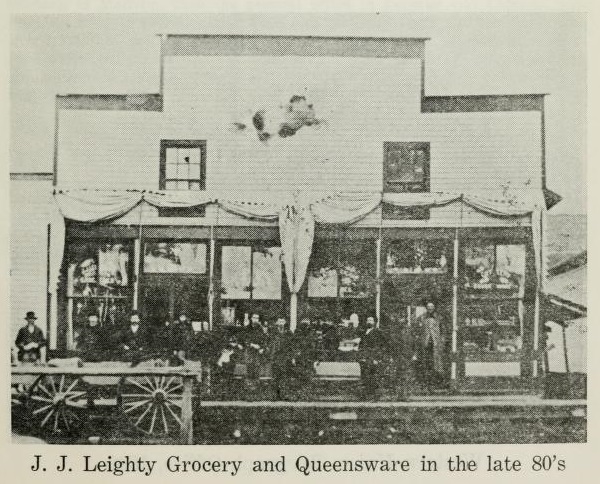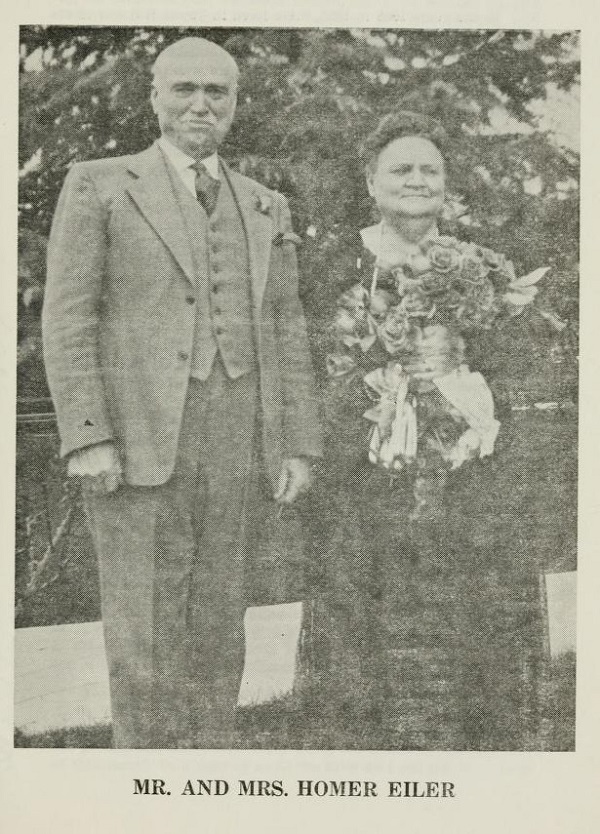1973 Tower Hill
History of Tower Hill and Vicinity written by Homer Eiler, published in 1973, 92 pages.
[Page 12]
Cold Spring has the record of the first land entry in Shelby county issued
to Charles Wakefield, Sr., July 19, 1821. But the coming of the railroad to
Tower Hill spelt the doom of Williamsburg and all other near frontier
villages, so that today they are only a memory.
[Page 13]
I have spoken of that earliest settler, the Wakefield family. Close upon
their coming was Thomas Pugh with his family from Kentucky about 1820, and
settled also in Cold Spring, near the Wakefield settlement. Later he removed
to the Knobs vicinity, and there raised his family. The name Pugh is a
household word to this day in Tower Hill and vicinity, and many descendants
still live here. The Rhodes family, the Thomas Eiler family, and many who
still carry the same Pugh in the male line.
Jonathan C. Corley of Kentucky came about 1823 settling first at Robinson
Creek, which had at that time attained quite a settlement. In fact many of
the Tower Hill residents can claim that section as the first settlement of
their ancestors. It is recorded that Mr. Corley was the first blacksmith in
Shelby county.
Levi Casey, another Kentucky pioneer, also settled in Robinson Creek about
1824.
Tower Hill vicinity was largely settled by Kentucky folks. This is true of
my own ancestors through the Sharrock-May line. John May, my
great-grandfather, came from Prestonburg, Ky., about 1830, finally locating
with his large family of ten children, about two hundred yards or more
directly northwest of where Charley Smith now lives on the old Sammy Smith
homestead. Here he lived for several years, but after the death of his wife
and the children had married off, he went to live with his daughter
Catharine, the wife of John Sharrock, where he died in 1849, and is buried
in the Middlesworth graveyard, about a mile north of Tower Hill. The reader
will please pardon a personal allusion, but upon a recent visit to this
spot, it was easy to follow the foundation outline one hundred years ago.
The rotted stumps of mulberry trees is the yard were still visible. All
these spoke to me in greater volumes than words, of the children who had
romped about, and especially little Catharine, who later became my
Grandmother Sharrock.
James Abbott, another Kentuckian, who preceded John May, was the original
one to enter this old May homestead, selling out to him.
The great immigration to old Shelby seems to have been in the 30's and the
majority from Kentucky and Tennessee. Later in the 40's the settlers were
from Ohio and the eastern states.
From the records I find a Burwell Massey settled near the Knobs about 1830.
Also one Daniel Agles at the same time, but I am not able to place that
name. The Smith family came from Kentucky,
[Page 14]
settled in this vicinity about 1831, and our old respected Uncle Sammy
Smith was a boy of about 7 years of age when his father cast his lot as a
pioneer among these early settlers.
A talk with Charley Smith, one of Tower Hill's most respected citizens and a
descendant of this Smith family, can reveal to you the sturdy nature of
these old pioneers, and the deep seated religious nature practiced in their
daily walk. And how when the Sabbath day was approaching it became necessary
on Saturday to make all due preparations to carry the family over the
hallowed day with the least bit of labor. It was to this pioneer family a
day so sacred that the utmost precaution was made to see that the family was
not molested at all in their holy devotion.
Peter Killam, another Kentuckian, was a settler in the Knobs region about
1830. Here is a family that for all these years have been among the
respected residents of this community. Many descendants still live in the
vicinity.
Franklin Hudson settled in 1832 on what is now the Neil place. The Neil
family were from Tennessee and came early in the 30's settling in the Knobs:
region. Here is another old family who have been active in all affairs that
build up for a better community. There are many descendants still living
near the old home site
W. W. Peek, also from Tennessee, settled near Shelbyville at first about
1834, later in Rose township. A few descendants still live near the Hill.
Washbourne Wade came from Ohio about 1837 settling on the land where we
recorded Westminster. He lived to a very old age. Benjamin Hobson from Ohio
settled in this region.
Jonathan Riley came also the same time from Ohio. Gassett Horace, also from
Ohio in 1837, settled on what was later known as the Jester place. In fact
he sold out to Stephen Jester about 1841. Daniel Puckett, another pioneer
from Ohio about 1837 settled in the vicinity of Westminster. Most of these
names are still household memories, and descendants of nearly all still live
in the vicinity of the residences of their ancestors.
Thomas W. Craddick, a familiar name in Tower Hill during the passing generation, and specially remembered because they followed merchandising for most of their lives in this community, first settled near Robinson Creek, where it is recorded that he erected the first mill in western Shelby county. He soon removed to Westminster where we recorded he bought out the store of John Sharrock, and then to Tower Hill. Thomas Craddick was not only the first postmaster in Tower Hill, but the first justice of the peace, the first railroad agent.
[Page 15]
It was amidst such surroundings that the son Ambrose, known better by his
initials as A. M., learned the merchandise game which he followed for many,
many years in the Hill. In the early 70's A.M. and my father Lewis Eiler
were in the general merchandise business, under the firm name of Craddick &
Eiler.
A. M. Craddick became one of Tower Hill's foremost citizens holding many
public offices, finally becoming county treasurer. He married the daughter
of another pioneer merchant, namely John Moore, of the firm of Corley &
Moore.
Abraham Middlesworth was another Kentucky settler but near Shelbyville at
first, later living on what is now the old Middlesworth homestead about two
miles north of Tower Hill. Here the son, Ner, built a substantial brick
residence in the early 60's that is a credit to any community to this day-
(By the way of personal mention, my father when a young man helped burn the
bricks for that house.) Ner Middlesworth raised a large family here, and
several are yet alive and live in old Shelby.
Thomas May, the son of our John May, settled in 1840 near Westminster on
what is now known as the Weller place. In 1846 he sold out and removed to
Oregon where he became a prominent citizen in his community. It might be of
general interest to say here that the history of Oregon records our Thomas
May as being among the first who set out extensive orchards in Oregon, he
having purchased the sprouts in San Francisco enroute.
Everard Sharrock, our great-grandfather, came from Ohio about 1832 and first
settled in Christian county, but soon moved over the line into old Shelby
settling on Flat Branch. We have recorded his doings at Westminster and
later removing to Oregon.
Conrad Hanson was an old settler coming directly from Indiana about 1832,
settling just west of the John May settlement. He had a large family of
twelve children who mostly settled around Tower Hill in their early married
life. There are many direct descendants still living in the community.
Conrad died in 1853 and is buried near John May, his brother-in-law, in the
Middlesworth graveyard.
The Ferryman family were very early settlers over on Mitchell Creek near
Shelbyville, but later moved near the Rocky Branch region where the family
grew up as part of the Tower Hill citizenry. One son born on Mitchell Creek
in 1836 named J. W. Perryman is still alive, aged 90 years, and lives near
Oconee. I understand he has written a book entitled, "Ninety Years in
Illinois."
I'll warrant it would be interesting reading. He had already published a
volume of poems and early reminiscences.
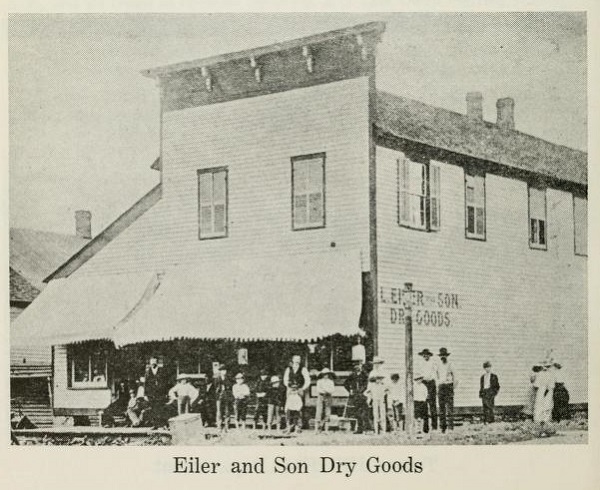
[Page 16]
Conrad Eiler came to Tower Hill with the immigration from Ohio and the east
that came in the 40's he coming in 1849, settling on the old Eiler
homestead, new occupied by Oscar Warren. Here with the family of four boys
born in Ohio, he grappled with the task of making a home, succeeding amidst
all the hardships that come to all pioneers. Conrad Eiler though had a
greater vision than the bounds of his own homestead, it was the interest of
the community. So the Eiler Church became the great center for religious and
social welfare, and to this day is a household name far and wide.
With Conrad Eiler came other Ohio folks, the Warrens, Messicks, Wireys,
Jesters, and others, all names being among the prominent families cf this
community. And the list is lengthy, and time and space would fail me to
mention them all, but these are familiar names as follows: Bonser, Metsker,
Andes, Higginbotham, Brownback, Hooks, Harper, Story, Evey, Cannon, Stumpf,
Morgan, Fringer, Fluckey, Scovil, Hunter, Bowman, Dutton, and scores of
others. But a visit to the old time cemeteries will reveal other names whose
descendants moved away years ago, or death has ended the line.
...
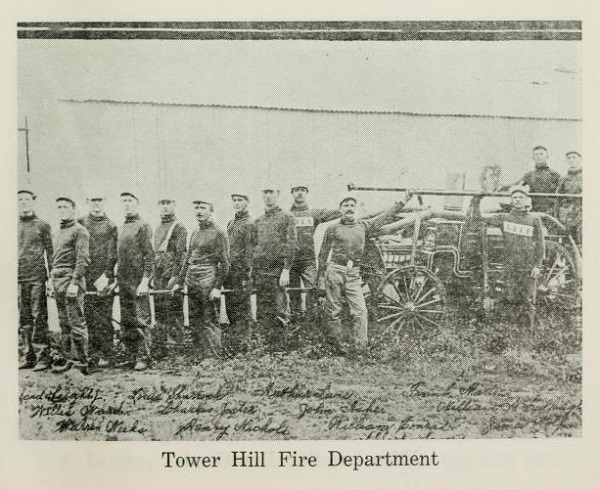
[Page 39]
It is stated here that the new Howe fighting fire equipment had recently
been purchased and this was a fair lest of its ability.
The next one is dated Jan. 27, 1905 starting on Sunday morning about 3 A.M.
and destroyed the A. R. Robinson and Miller buildings. Another one not dated
was the destruction of the Price elevator. Then later the fire on the west
side, destroying the Eiler & Son building and adjacent structures. Then
shortly the Gross Hotel, and in later years the Wilkinson building. So Tower
Hill has been rebuilt over and again because of her many disastrous fires.
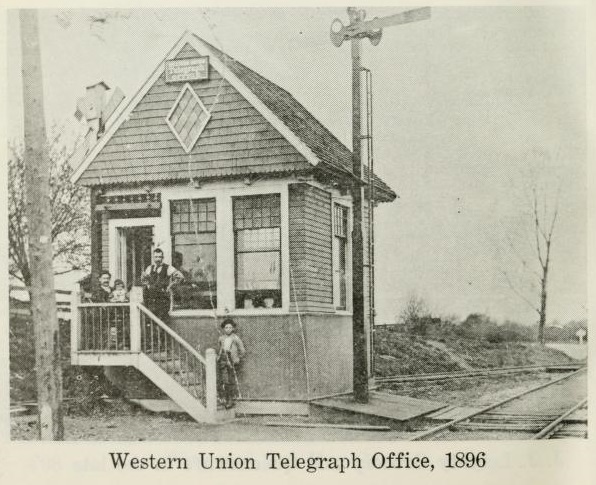
THE DOCTORS [Page 39]
Tower Hill has been very fortunate in its past history to boast of a spleen
did array of medical talent, in fact, above the average for a village of
this size. Unfortunately I am unable to appeal to a real pioneer who can
assist me as to the early history of the physicians who were residents in
the Hill even from the beginning down thru the Civil War days and into the
early 70's.
But probably as in all pioneer villages there were numerous so-called
"country doctors" more from a neighborhood experience and a natural instinct
as "good in sickness" rather than their knowledge of medical science.
Then in birth cases there were women in every community who were called on
to assist. In fact, women in pioneer days were almost universally demanded
in this particular case of medical need, known as mid-wife.
Right here I can record a bit of family knowledge that has come down in our
family from authentic sources regarding the part women played in sickness in
the community.
I refer to my great-great grandmother, Mrs. Mary Magdalene (Wall) Hanson,
the wife of our Revolutionary ancestor, John Hanson. She was born in 1765 in
Virginia, and died in the "Knobs" community in 1845, and is buried in the
abandoned Milldesworth cemetery, a mile and a half north of Tower Hill.
Her tombstone is standing and in good state of preservation, and I would be
pleased to have my friends visit the spot and place a wreath as a token of
her services in pioneer days. No doubt at all but what she was present in
scores of cases of births of ancestors of many citizens of our community.
She was known all over this section of the country for her ability in
handling very successfully all manners of ailments. I mention this
particular case, because she was typical of many in pioneer days, who
assisted by means of common knowledge of using "herbs" and homemade
appliances, battled very successfully with all manner of ailments common to
the early settler.
The men folk were active also in lines of service requiring more acute skill
and strength, such as setting broken bones, dislocated joints, pulling
teeth, bleeding a patient and other such strenuous cases as the necessity
demanded.
Again I call attention to another one of our family, and known by many in
this community. I refer to my grandfather, John Sharrock, who came to this
community in 1832 and died in this village in 1896.
[Page 40]
He was a pioneer in the early 40's with his wife (Catherine May) living on
the Sharrock homestead, about a half mile due east of the Eiler cemetery in
what is now a plowed field.
I have in my possession an account from Headen Neil, known by many here, of
the part "Uncle" John Sharrock played in the role of country doctor. He was
being constantly called on to assist in setting broken bones, dislocated
joints, and pulling teeth, and bleeding folks. Only recently it was my
privilege to see the forceps he used in this pioneer dentistry. They sure
are cruel looking instruments, not so much in the pulling process but a
twisting affair that certainly was very painful, bordering on torture.
It is recorded in our family that he would be called at all hours of day and
night in the midst: of his daily work, but never too busy to lend aid to to
one in distress. I refer particularly to broken bones and such surgical work
that required strength and nerve. Even at the noon meal time a rider would
come galloping into the yard urging immediate help, a as neighbor had met
the misfortune in breaking an arm or leg or something else as serious.
Throwing a sheepskin over his favorite traveling horse, perhaps bare-headed
and coatless, he rode at breakneck speed to the neighbor needing immediate
assistance. From his pioneer experience and unspeakable nerve in handling
these extreme surgical cases, being taught from his childhood how to handle
these serious mishaps, he became skilled in this activity of needed
assistance.
Never receiving any "pay" as it was the pioneer custom for everyone to
assist the community in any manner where help was needed. If anything
approached to payment, it was rendered by lending assistance at hog-killing
times, or rail splitting, or some farm task.
So this is a partial picture of early days around Tower Hill before the
advent of the "Diploma Graduate" physician.
The average pioneer community were slow in admitting the "newcomer" with his
sheepskin guaranteed knowledge of all the ailments the human body was
subject, and the university remedies recommended for a cure.
This primitive description of the old-fashioned country doctor brings us
down to the period of the Civil War and the 70's.
And here your writer can stretch his memory to around the days of 1876.
My first dim recollection is of one whom I now look back and see bridged the
gap so to speak of the days of great-great-grandfather Hanson and
Grandfather Sharrock to the sheepskin graduate of medical science.
I refer to that old pioneer family doctor, of the early days of Tower Hill,
Doctor Brown, the father of the Brown family so well known even in this
generation, namely — Cass, John, Clark, Lucy, Mae and Ollie.
He was our family doctor, and honestly I feel I owe my life to his natural
skill and nursing me in a serious ailment, it being a relapse of that
dreaded child disease, the measles.
I have often heard my dear mother tell the story when I was so low when even
Dr. Brown led my mother from the sick room, saying, "Julia you had better
retire, for it will all be over in a few minutes."
[Page 41]
But she said "Doc Brown never left me a minute," working alone with all his
natural skill to thwart a fatality. And he won. I mention this because Dr.
Brown even with only one leg, was of that old type, using a common sense
diagnosis of the cause of the ailment, and applying home made remedies to a
miraculous success. Ke had if any, only a limited college medical education.
Along at this same period Tower Hill had 2 other physicians who were of the
university type, namely Dr. Fringer and Dr. Morgan. And they soon wove their
medical personalities into the favor of the community, so the days of the
old fashioned doctor was past. Dr. Morgan later gave up the practice and
engaged in the drug store business. I remember so distinctly that old drug
store, because at Christmas times it was the only place where toys and
candies were kept.
Soon another college doctor hung out his shingle in the Hill, a Dr. Hunt —
and I expect almost forgotten by the few old timers. Dr. Hunt was a scholar
and educator, taking a keen interest in the public school system, being a
member of the school board, and by his interest assisted greatly in making
the schools of that day well spoken of as to organization and high grade
teachers. Just as a proof take a glance of these names who even today are
recognized as examples not even excelled to this period.
Professors— W. G. Kelley (late Judge Kelley of Shelbyville). Wash Rarer
(Uncle, I think of Emma Freeze), T. C. Eiler, Cass Brown, Frances Baines, I.
L. Brant afterwards a prominent doctor in the Hill), C. O. Bennett
(afterwards a prominent physician in Missouri), and so on.
Dr. Hunt was here only a short time, removing about 1880 to Warsaw, Ill. Dr.
Fringer was a resident for many years — and remembered by many old timers.
Dr. Morgan after his wife's death sold his drug store to Dr. Fringer, and
with his daughter, Anna, removed to Denver, where he died only a few years
ago. Then came Dr. Shelton from the south and spent the remainder of his
life here. He was a well respected citizen, and his family entered into the
life of the community in an affectionate manner.
Then was added another doctor who endeared himself to the community — not
only from his medical experience but his interest in music. His life in our
midst needs no comment as well know by this generation. Up to about the year
1937 he is the only living doctor of our past medical history. I refer to
Dr. Young.
During this period of the late 80's there entered another university
graduate and with his many years of university experience he possessed what
is considered the greatest asset any physician can possess, that is a
natural instinct for diagnosing a sickness. I refer to my dearly beloved
uncle. Dr. I. L. Brant. He first settled in Lakewood, but soon felt the Hill
offered a more lucrative practice and a broader field of activity. It is
common knowledge that he was the most successful doctor in all manners of
sickness that ever lived in our community.
But his life was cut short by an early demise in 1897.
And here is where from a personal knowledge we close our history of the
medical fraternity, and record from now on the facts and information as
furnished by our able assistant Ed S. McLean:
[Page 42]
Ed writes me that the 90's recorded in addition to Doctors Brant and
Shelton, Dr. A. J. Humphrey, Dr. Frank Martin, a Tower Hill boy, so well
known and who married one of our home town girls, namely Miss Ollie
McCullough. As we all know Dr. Martin passed away only a few years ago in
Pana where he had removed and built up very lucrative practice.
Then another boy of the community hung out his shingle in our midst, Dr.
Homer Corley, who still resides in the village. Homer belongs to that old
pioneer family of Corleys who are connected not only with early pioneer life
but in the mercantile business and preaching profession as well.
From the period of 1900 to the present there has appeared other doctors, as
Dr. E. A. Dowell, and Dr. A. J. Hitt. I am informed that Doctors Corley and
Hitt are the present physicians in the village.
Two other doctors in dentistry are recorded as practicing their profession
at different periods since 1900, namely Dr. E. B. Strange, who married Miss
Floy Cannon of that old time respected family. Then Dr. John W. Green of the
same profession, who resided here from 1914 to 1926 and who also married
another of our home grown girls, namely Miss Ruth Foor.
And thus ends our record of the medical fraternity.
...
